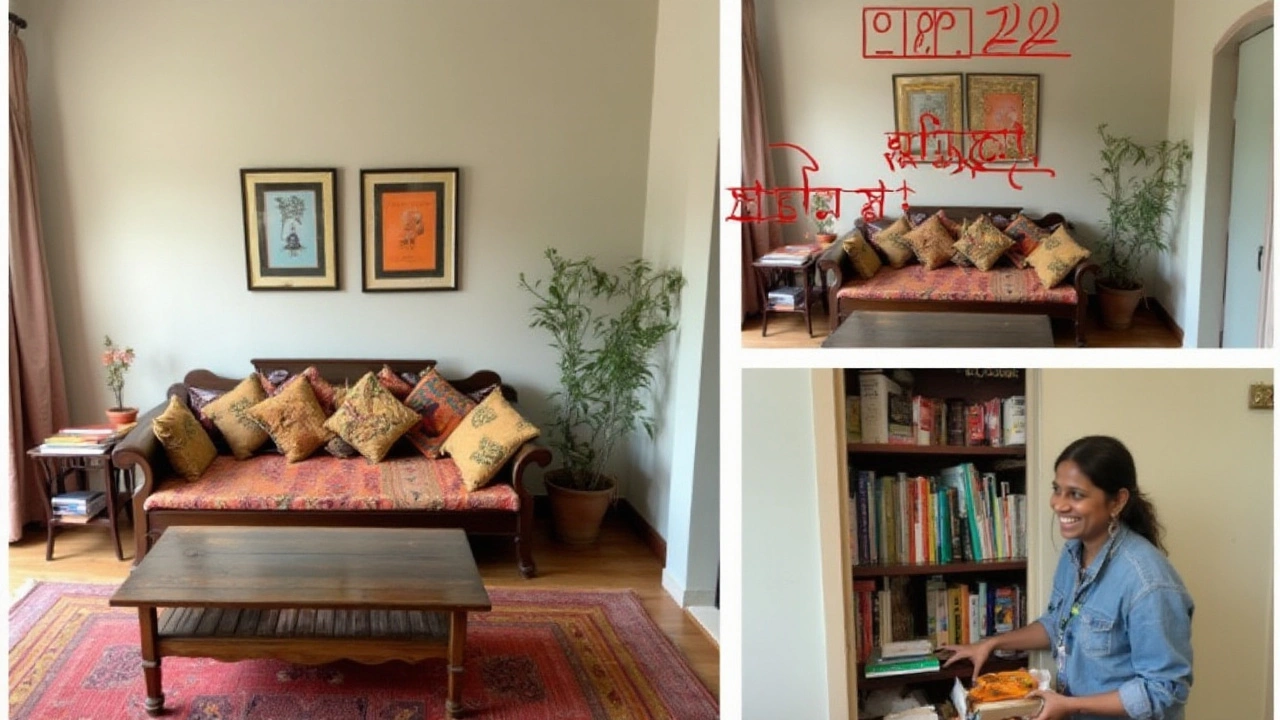Master Decluttering with the 12-12-12 Rule: A Simple Guide

In today's fast-paced world, clutter can easily invade our homes, creating chaos and stress. Yet, taking charge of your space doesn't have to be overwhelming, thanks to the innovative 12-12-12 rule. This straightforward approach to decluttering is both efficient and engaging, inviting you to tackle the items in your home with purpose.
Imagine choosing 12 items to donate, another 12 to discard, and 12 more to return to their rightful places. It's not just a decluttering strategy; it's an opportunity to reflect on your belongings and their role in your life. This method turns a daunting task into a manageable, even fun, activity that encourages regular engagement.
Join us as we explore the ins and outs of the 12-12-12 rule, shedding light on its benefits and offering tips to help you stay on track. Whether you're a seasoned organizer or just starting out, this guide is your companion for reclaiming order in your home.
- Understanding the 12-12-12 Rule
- Why Declutter? The Psychological and Physical Benefits
- Step-by-Step Guide to Implementing the Rule
- Common Challenges and How to Overcome Them
- Maintaining a Clutter-Free Home
Understanding the 12-12-12 Rule
The 12-12-12 rule is a simple yet effective strategy for tackling clutter in your home. This method is designed to make the daunting task of decluttering more manageable by breaking it down into a set of straightforward actions. At its core, the rule involves identifying 12 items to donate, 12 items to throw away, and 12 items to return to their proper place within your home. The idea is that by completing these actions, you systematically reduce clutter without feeling overwhelmed, making storage solutions more accessible.
Originating from minimalism and organizational experts, the rule is praised for its accessibility and ease of implementation. It's versatile enough to be adapted to any space in your home, whether it's a cluttered closet or a messy garage. This method can be utilized weekly, monthly, or whenever you feel the need to regain control of your surroundings. Applying the rule consistently can lead to a significant positive change in your living environment, promoting a sense of peace and order.
Implementing the 12-12-12 rule isn't just about getting rid of things; it's about developing new habits and a mindset that values order and intention. According to the statistics, households that regularly engage in decluttering activities report increased happiness and satisfaction. In a survey conducted by the National Association of Professional Organizers, 91% of respondents said they would be more productive at work and home if their environment was better organized. Such data underscores the profound impact of maintaining a clutter-free space, both on an emotional and practical level.
"Our possessions should serve us, not the other way around," states renowned organizing consultant Marie Kondo. This reflects the philosophy underpinning the 12-12-12 rule, encouraging people to evaluate the role of each item in their life and make mindful decisions about what to keep, discard, or donate. It's a strategy that nurtures gratitude and consciousness about consumption habits, which in turn can lead to more sustainable lifestyle choices.
For effective application of the rule, start by gathering three boxes or bins: one for donations, one for trash, and one for items you plan to keep but which need to be returned to their rightful place. Begin in a specific area of your home, allowing yourself a set time to process 12 items in each category. You could proceed room by room or focus on a particular problem area. This focused approach ensures you don't feel like you're taking on too much at once, leading to a greater sense of accomplishment and motivation to continue.
Why Declutter? The Psychological and Physical Benefits
In the whirl of modern life, clutter often sneaks in unnoticed, yet silences our peace of mind and disrupts our spaces. When you start the journey of decluttering, you're not just tidying up your environment but also giving your mental and physical health a meaningful boost. The reduction of clutter can significantly decrease anxiety by creating a serene and orderly environment. Research indicates that organized spaces can lower cortisol, the stress hormone, helping individuals feel less overwhelmed. When everything is in its place, the brain doesn't have to work overtime trying to make sense of chaos. In fact, the benefits of a neat environment mirror those experienced during mindfulness practices, bringing a sense of calm and control.
Moreover, decluttering improves physical health. Cleaner and more organized homes lead to fewer accidents and provide a safer living space. Decluttering involves physical activity, which is beneficial for the heart and muscles, burning calories as if engaged in a mild exercise routine. The National Sleep Foundation has also found that people with tidy bedrooms sleep better, giving a compelling reason to maintain order. With better sleep and reduced stress, your outlook on life can become more positive, which can significantly impact physical well-being.
Enhancing Decision-Making Abilities
Clutter isn't always benign; it can muddle decision-making. When surrounded by stuff, making choices becomes challenging. You might be caught in indecision over what to wear or use, wasting valuable time. Decluttering fosters a clearer environment, which supports clearer thinking. By organizing your belongings, you often find that your life decisions follow suit—rendering you more focused, productive, and prepared.
Boosting Creativity and Productivity
The impact of a clean space on creativity is profound. In clutter-free zones, the brain finds the freedom to wander into imaginative territories. Many creatives bask in minimalistic spaces to nurture their artistic endeavors. Similarly, productivity thrives in such environments. One striking anecdote comes from Steve Jobs, who famously embraced minimalism to enhance his concentration and creativity, preferring an uncluttered space to innovate the future.
"The ability to simplify means to eliminate the unnecessary so that the necessary may speak." — Hans Hofmann
Clutter not only occupies physical space; it can also occupy mental space, making it difficult to focus on work tasks. A study by the Princeton University Neuroscience Institute confirms that physical clutter decreases attention, performance, and increases stress. Through home organization, distractions diminish, mood elevations occur, and productivity often surges in ways that one might not initially anticipate.
The correlation between our environment and well-being is undeniable. By embracing organization, the rewards go beyond the physical realm—touching on emotional, mental, and even relational prosperity. Embark on this journey towards a clutter-free lifestyle and watch as it breathes new life into your days, turning your home into not only a place of respite but a powerful ally in your quest for health and happiness.

Step-by-Step Guide to Implementing the Rule
Embracing the 12-12-12 rule can truly revolutionize how you organize your home. The beauty of this method lies in its simplicity and flexibility. To start, gather your family or roommates, as decluttering together can add a social and engaging element to the task. Begin with a small area of your home, one that you frequently use, and it's essential to set the scene with a calm mindset to stay focused and avoid getting overwhelmed.
Start by identifying 12 items that can be donated. This could range from clothing you no longer wear, books you've already read, or kitchen gadgets collecting dust. Consider local charities or neighbors who could benefit from these contributions. As consumerist Henry David Thoreau once said,
“The price of anything is the amount of life you exchange for it.”Reflect on what is meaningful and what can bring value to others, rather than just to you. Once you’ve set aside these items, you’ll likely feel a sense of relief knowing they’re going to a new home.
Next, move on to the 12 items you wish to throw away. These are things that are beyond repair or simple garbage that has overstayed its welcome. Be honest with yourself and separate emotion from practicality. It's surprising how quickly clutter can seep into every crevice—an old magazine pile, broken electronics, or expired products. Simply toss these out and make room for the positive energy and space that an uncluttered area brings.
Finally, focus on 12 items that need to be put back in their proper place. It's not just about tossing unnecessary things, but also about organizing what you wish to keep. Ensure that everything has a designated spot, which helps in maintaining long-term tidiness and ease. For instance, return dishes to the kitchen, books to the shelves, and toys to their storage boxes. Over time, this practice will not only make organizing easier but also foster a habit of returning things to where they belong.
For those interested in tracking their decluttering progress, here’s a suggestion: create a simple
| Category | Items |
|---|---|
| Donated | 12 |
| Discarded | 12 |
| Organized | 12 |
Common Challenges and How to Overcome Them
Implementing the 12-12-12 rule sounds simple at first glance, but like many things in life, it comes with its own set of challenges. One of the most common obstacles is the emotional attachment people have to their belongings. Items often hold sentimental value, making it difficult to decide what to part with. The trick is to focus on functionality over attachment. Ask yourself if an item is truly adding value to your life, or if it's just taking up space. For those struggling with this step, it might help to start with areas of the home that don’t hold much emotional significance, slowly building confidence to tackle more personal spaces.
Another challenge is feeling overwhelmed by the sheer volume of clutter. When you look at a room filled with items, it's easy to feel defeated before even starting. One effective strategy is to break down the decluttering process into smaller, more manageable tasks. The beauty of the 12-12-12 rule lies in its simplicity. Begin with just twelve items at a time, which psychologically reduces the burden and makes the task seem less daunting. Consider setting a timer for thirty minutes and tackling specific areas or categories of items, creating a sense of urgency and focus that helps maintain momentum.
Moreover, procrastination often rears its unhelpful head when facing a decluttering mission. Here, setting specific deadlines can be a game-changer. Create a schedule for regular decluttering sessions and stick to it as if it were an important appointment. In the words of Marie Kondo, "The objective of cleaning is not just to clean, but to feel happiness living within that environment." Embrace each session as an opportunity to bring more happiness into your home and life.
Space constraints can also pose significant challenges. Many dwellers in urban areas find that limited storage solutions make decluttering a weekly necessity. One solution is to think vertically when it comes to storage. Utilize wall space with shelves or hooks for items you use regularly but don't necessarily need within arm's reach. Creative storage solutions prevent re-cluttering and maximize your living area, providing a more organized space that supports your lifestyle rather than hindering it.
Finally, motivation is often hard to maintain, especially when progress appears slow. Celebrate small victories to keep spirits high. Once a month, take stock of the changes you've made and the items you've cleared out. Visual progress can be incredibly motivating.
| Challenge | Solution |
|---|---|
| Emotional Attachment | Focus on functionality and tackle non-emotional areas first |
| Overwhelm | Break down tasks and start with twelve items at a time |
| Procrastination | Set deadlines and make decluttering sessions appointments to keep |
| Space Constraints | Use vertical space and creative storage solutions |
| Maintaining Motivation | Celebrate progress with visual markers |

Maintaining a Clutter-Free Home
Keeping a home free from clutter is not merely about organizing; it’s about cultivating a lifestyle that values space and simplicity. Once you've successfully decluttered using the 12-12-12 rule, the challenge becomes maintaining that newfound sense of order. To do so, creating regular habits that incorporate minimal effort yet yield significant results is essential. A clutter-free environment not only enhances aesthetic appeal but also boosts mental clarity, allowing the mind to relax without distractions.
Start by establishing a daily routine that involves dedicating a small portion of your time to tidying up. Before the end of the day, spend just 15 minutes ensuring that items are returned to their designated places. This simple act prevents the build-up of clutter, and over time, the routine becomes intuitive. It’s much easier to tackle small tasks frequently than to face a daunting pile of disorganization all at once. Encouraging family members or housemates to participate in these daily tidies can also help instill this habit as a collective responsibility, fostering a sense of shared ownership over the living space.
A useful strategy for maintaining cleanliness is the 'One In, One Out' policy. Whenever a new item is brought into the home, consider parting with an old item that might have served its purpose. This method prevents an accumulation of unnecessary items and forces you to ponder over each new possession's value and necessity. Minimalism inspires mindful consumption, reducing the stress associated with potential clutter. The idea isn't about depriving yourself, but rather ensuring that each item plays a role in enhancing your life.
"The space in which we live should be for the person we are becoming now, not for the person we were in the past." - Marie Kondo
Aside from these practices, seasonal organizing can greatly contribute to maintaining tidiness throughout the year. Consider dedicating the start of each season to reassess and reorganize your home. This involves examining your wardrobe, living areas, and storage solutions, ensuring that everything aligns with your current needs and preferences. Seasonal transitions can often prompt changes in our routines and lifestyles, making them the perfect opportunity to evaluate and adjust our environment accordingly. In this setup, the primary goal is adaptability, allowing your space to reflect the changes in your life seamlessly.
Technology can also be a powerful ally in keeping your home organized. With smart apps and tools, you can digitally track your belongings and create inventories, reminding you of what you own and reducing the likelihood of redundant purchases. Furthermore, apps can send reminders for regular cleaning sessions or schedule donation pickups, making the process more manageable and less time-consuming. As you harness these digital solutions, you’ll find that maintaining a clutter-free home becomes not only easier but also more rewarding.